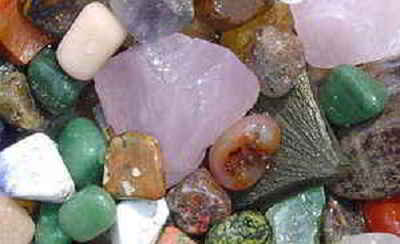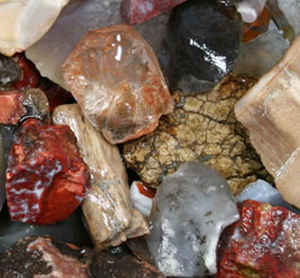Wisconsin State Rock
Red Granite

Adopted on March 9, 1971.
Wisconsin designated red granite its state rock on March 9, 1971 after the Kenosha Gem and Mineral Society proposed a mineral and rock be chosen to promote geological awareness.
Red granite was chosen because of its abundance, uniqueness, economic value, and historical significance. The Kenosha Gem and Mineral Society proposed the bill for the state mineral and rock.
Red Granite is mined in several sections of the state. It is an igneous rock and is composed of quartz and feldspar. It was selected because of its economic importance.
Among the most popular, the hardest, and the oldest of geosymbols, granite is an official symbol of New Hampshire, Massachusetts, North Carolina, South Carolina, Vermont, and Wisconsin.
Wisconsin State Rock: Red Granite

Granite is a common
and widely-occurring group of intrusive felsic igneous rocks that forms at great depths and pressures under continents. Granite consists of orthoclase,
plagioclase quartz, hornblende, biotite, muscovite and minor accessories such as magnetite, garnet, zircon and apatite minerals. Rarely a pyroxene
is present. Ordinary granite always carries a small amount of plagioclase, but when this is absent the rock is referred to as alkali granite. An increasing
proportion of plagioclase feldspar causes granite to pass into granodiorite. A rock consisting of equal proportions of orthoclase and plagioclase plus
quartz may be considered a quartz monozonite. A granite containing both muscovite and biotite micas is called a binary granite.
The word granite comes from the Latin granum, a grain, in reference to the grained structure of such a crystalline rock.
Granite occurs as stock-like masses and as batholiths often associated with mountain ranges and frequently of great extent. Granite has been intruded
into the crust of the Earth during all geologic periods, except perhaps the most recent; much of it is of Precambrian age. Granite is widely distributed
throughout the Earth.
Because of its hardness and comparative cheapness in relation to marble, granite is often used to make kitchen countertops. A granite countertop can
be cut in any shape, and it is virtually unscratchable. Very hot pots must not be placed onto it though, because the temperature differential could
possibly crack the granite
How to recognize red granite
- From a distance, it looks reddish or pink. Up close, you will also see dark gray and purplish spots.
- You can't scratch granite with a nail or knife. (See more about the scratch test.)
- Some broken surfaces have flat surfaces that shine in sunlight.
- Granite is made mostly of the minerals feldspar and quartz. (Reddish feldspars give this granite its color and break to form flat surfaces. The quartz crystals may be a semi-clear grayish or purplish color.)
-
Many granites also contain small crystals of mica or darker minerals.
The Rock - GRANITE
Granite is a light-colored igneous rock with grains large enough to be visible with the unaided eye. It forms from the slow crystallization of magma below Earth's surface. Granite is composed mainly of quartz and feldspar with minor amounts of mica, amphiboles and other minerals. This mineral composition usually gives granite a red, pink, gray or white color with dark mineral grains visible throughout the rock.
- Igneous Rock Type: Intrusive
- Related to: Rhyolite, pegmatite, syenite
- Chemistry: Acidic
- Color: White, pink, orange, gray, black
- Texture: Phaneritic (easy to see crystals)
- Origins: Orogenic Plutons
- Common Minerals: Quartz, feldspars, hornblende and micas
- Accessory Minerals: Tourmaline, phosphates, rare earth oxides, beryl, topaz, zircons, augite, sphene and apatite
- Uses: Building material, decorative counter tops, tiles, tombstones, roads, jewelry, curling stones, marbles
Wisconsin Law
The law designating red granite as the official Wisconsin state rock is found in the Wisconsin Statutes, Chapter 1, Section 1.10(3)(o)
1.10 State song, state ballad, state waltz, state dance, and state symbols.
(3) The Wisconsin state symbols are as follows:
(o) Red granite is the state rock.
Minerals, & Gems

Gemstone, Minerals, Rocks







